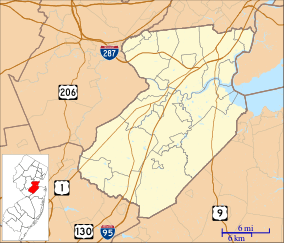T. A. Gillespie Company Shell Loading Plant explosion
|
Residents of Morgan, NJ flee from the explosions to Perth Amboy | |
| Time | 7:36 PM EDT |
|---|---|
| Date | October 4, 1918 to October 6, 1918 |
| Location | Sayreville, New Jersey |
| Coordinates | 40°27′25″N 74°16′12″W / 40.457066°N 74.269992°W |
| Also known as | Morgan Munitions Depot |
| Cause | Worker error or (speculative) German sabotage |
| Participants | US Coast Guard, US Army |
| Outcome | Plant abandoned following Armistice |
| Deaths | ~100 |
| Injuries | 100+ |
| Missing | ~18 |
| Property damage | Complete destruction of plant ($18 million in 1918); major damage to 300+ buildings in Sayreville, South Amboy, and Perth Amboy, NJ |

The T. A. Gillespie Company Shell Loading Plant explosion, sometimes called the Morgan Depot Explosion, occurred at 7:36 p.m. on October 4, 1918 at a World War I ammunition plant operated by the T. A. Gillespie Company and located in the Morgan area of Sayreville in Middlesex County, New Jersey. The initial explosion, generally believed to be accidental, triggered a fire and subsequent series of explosions which continued for three days. The facility, one of the largest in the world at the time, was destroyed along with more than 300 buildings, forcing reconstruction of Sayreville and neighboring South Amboy.[1]
T. A. Gillespie
T. A. Gillespie Company, a subsidiary of the American Shell Company, was loading shells for military action during World War I. The company was renamed Gillespie Motor Company in 1919, merged to form Gillespie-Eden Corporation in 1920, and disappeared sometime after 1923.[2]
Damages
Damage to the plant was estimated to be US$18 million[3] and the US Government paid US$300,000 in insurance to area residents, respectively equal to approximately $300 million and $5 million in 2012 dollars. According to a 1919 government report, the explosion destroyed enough ammunition to supply the western front for six months, estimated at 12 million pounds (6 kilotons) of high explosives.[1]
Casualties
Martial law was declared following the accident, forcing the evacuation of Sayreville, South Amboy, and Perth Amboy, whose combined populations totaled approximately 62,000. The death toll for the accident is unclear, since employment records were destroyed by the explosion, but it is assumed to be over 100 persons, with hundreds more injured.[1][3][4] The unidentified remains of 14 to 18 workers were buried in a mass grave on Ernston Road in Old Bridge.[5] Evacuated and homeless persons were more susceptible to the severe influenza pandemic that struck a few weeks later, and the area's death toll from the outbreak was high.[1][6][7]
Coast Guard involvement
Among many others involved in rescue operations were a number of United States Coast Guardsmen stationed across the Raritan River in Perth Amboy. Twelve received Navy Crosses for their heroic actions in the aftermath of the explosion, and two died in the effort. The award citations indicate that during the conflagration, they risked death when they relocated a train loaded with TNT that was threatened by the fire. One Navy Cross recipient was Joseph Stika, who later became a Vice Admiral.[8]
Legacy
The explosions scattered debris over a wide area, more than a mile in radius. As late as 2007, unexploded ordnance or other material from the facility was being found in the surrounding area. On June 7, 2007, ordnance was found at Samsel Upper Elementary School while workers were grading an area for a playground. Explosive Ordnance Disposal experts from the US Army were called in to remove the material.[9] Previously, in 1994 and again in 1997, the discovery of shells near Sayreville's Dwight D. Eisenhower Elementary School spurred cleanup operations by the United States Army Corps of Engineers, which collected and disposed of a combined total of 5,080 pieces of ordnance.[1][10]
Local historian Frank Yusko produced a 1994 television documentary about the explosion.[11]
The sports teams of Sayreville War Memorial High School are named the Sayreville Bombers, recalling the town's World War I ammunition plants and many World War II veterans.[12]
See also
- List of the largest artificial non-nuclear explosions
References
- ↑ 1.0 1.1 1.2 1.3 1.4 "For 3 days, the ground shook in South Amboy". The Star-Ledger. October 4, 1998.
- ↑ "Gillespie Motor Co. – History". VintageMachinery.org.
- ↑ 3.0 3.1 "Great Munition Plant Blown Up; 100 May Be Dead". The New York Times. October 5, 1918.
- ↑ "Day of Explosions and Fire Finishes Shell Plant Ruin". The New York Times. October 6, 1918.
- ↑ Unofficial Arlington Cemetery page. Frederick J. Birkett III.
- ↑ "Morgan Munitions Blast Remembered 80 Years Later". Home News Tribune. October 4, 1998.
- ↑ "Explosions devastated Morgan 90 years ago". The Suburban. October 16, 2008.
- ↑ "Recipients Of The Navy Cross – The Gillespie Plant Explosion". HomeOfHeroes.com. Retrieved December 13, 2014.
- ↑ "Old military explosive unearthed in schoolyard". The Suburban. July 6, 2007.
We find these things a couple of times a year in town.
- ↑ "75-year-old ordnance cleared from schoolyard". American City and Country. March 1, 1995.
- ↑ Yusko, Frank (1994). The Morgan Explosion of 1918. Visionary Video Studios.
- ↑ "Sayreville War Memorial High School". Retrieved October 13, 2014.
